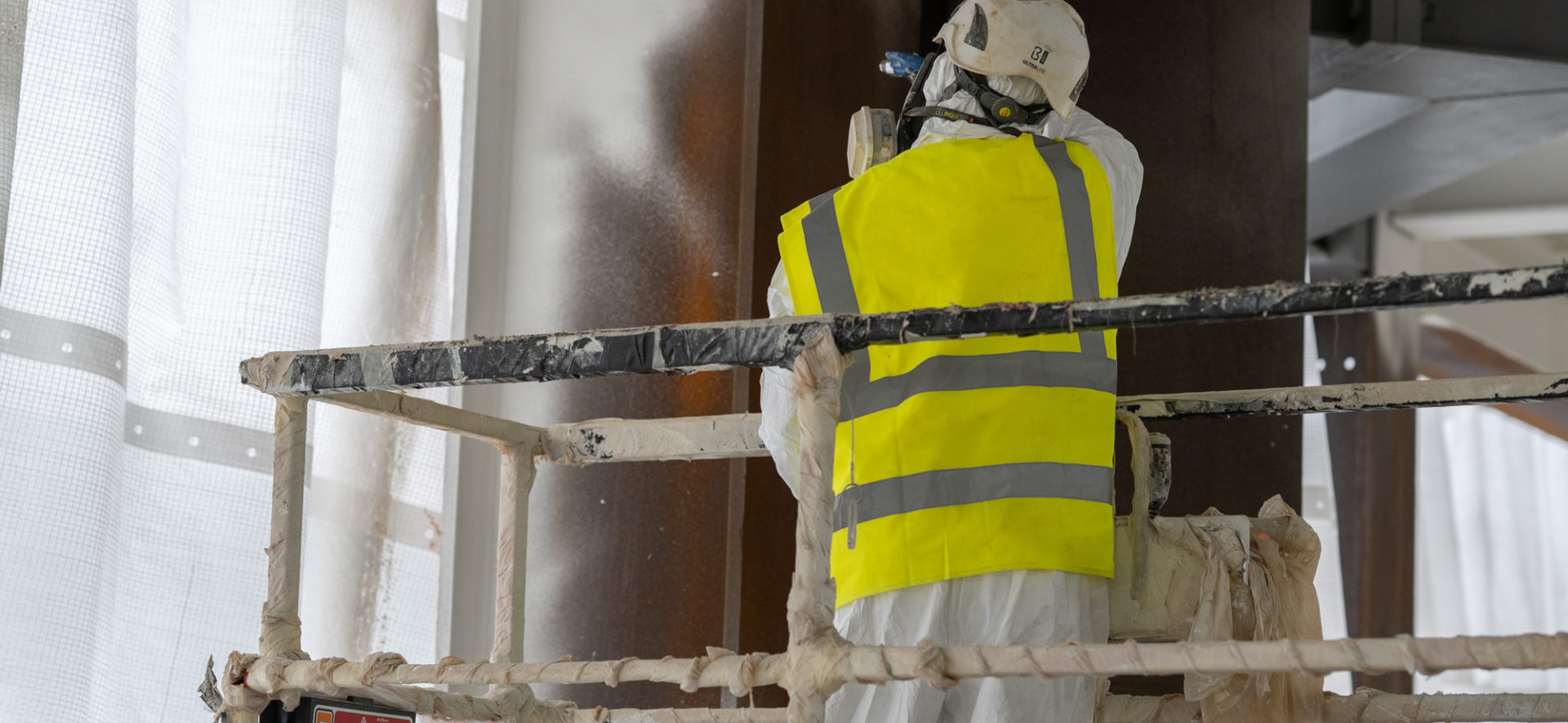Intumescent paint is a crucial element of many passive fire protection strategies. When applied in line with fire protection regulations, this substance increases the fire resistance of various structural elements such as steel columns, beams and timber frames. In the event of a fire, intumescent paint helps mitigate the risk of structural collapse, giving emergency services ample time to safely evacuate a building.
This article will summarise the role of intumescent paint in structural fire protection, before sharing some advice on best practice for applying intumescent paint as part of a construction project.
How does intumescent paint react to fire?
The word ‘intumescent’ derives from the Latin word intumesco meaning ‘to swell’ or ‘rise’. Extreme temperatures cause an exothermic reaction in the compounds found within intumescent paint. More specifically, these compounds expand at a rate of up to 50 times the paint’s original thickness. This creates a carbonaceous ‘char’ layer with low thermal conductivity, improving the fire resistance rate of an exposed surface.
Layers of intumescent paint vary in thickness between 0.8 to 13mm, and the paint itself remains dormant until the event of a fire. This means it can be applied to many structural elements without compromising their functionality or mechanical properties, providing that there is enough of a gap for the paint to properly expand as required.
What materials can be protected with intumescent paint?
In the construction industry, intumescent paint is most commonly used in structural steel. While steel is highly regarded as a robust building material, it can only withstand fire damage for so long. Steel begins to soften when exposed to temperatures above 425°C, with a high risk of structural collapse if temperatures exceed 600°C (depending on the weight of any load it is bearing).
With the speed at which fire can both spread and increase in temperature, the period in which a steel framework can withstand fire damage may be as little as 15 minutes. With intumescent paint, however, this fire resistance period can increase to up to 90 minutes in compliance with structural fire safety regulations.
Steel is one of several common construction materials that can be fortified using intumescent paint. For example, while timber is reasonably fire-resistant compared to other types of wood, intumescent paint can offer up to 60 minutes of fire resistance. There are also various brands of intumescent paint for internal plasterboard. These are often used for historical properties with plaster surfaces and features that cannot be removed due to listed building regulations.
Application methods for intumescent paint
Intumescent paint can be applied in several ways depending on the type of building, not to mention specific project requirements such as budget and turnaround time. That said, the predominant method is spray application as a thin film coating. Thin film coatings are the industry standard for intumescent paint, although there are also ‘thick film’ coatings that are used in environments such as industrial plants where extreme temperatures are the norm. Thin film coatings are suitable for various structural materials and there is also the option for a decorative finish, although this should be confirmed by the manufacturer of the specific paint.
It is also possible to apply intumescent paint using a brush or roller. However, this is less suitable for large-scale projects where a spray application method is more efficient and offers a more consistent finish. This is important to bear in mind, as the efficacy of intumescent paint depends not only on its chemical composition but also on the quality of its application. The finer details of the application can also vary heavily based on the exact product used. Here are a few points that construction teams must consider:
Environmental conditions
The European Organisation for Technical Assessment (ETA) recommends a specific type of intumescent paint depending on environmental factors such as humidity and exposure to weather conditions. For example, Type Y intumescent paint must be used for internal and semi-exposed surfaces or structural elements, providing that there is no potential exposure to rain. To find out more, we advise you to look at the ETA’s Guideline for European Technical Approval of Fire Protective Products (Part 2).
On-site or off-site application
There are benefits to applying intumescent paint both on-site and off-site. For example, on-site application can help ensure that projects are delivered on time and within budget. However, off-site application allows for tighter quality control standards as well as the ability to monitor and control variables such as temperature and humidity. It can also reduce the risk of disruption to ongoing work carried out by other site teams.
Surface preparation
All surfaces must be properly treated for the application of intumescent paint to be effective. For structural steel, for example, teams will likely need to apply both an anti-corrosive primer and a topcoat. Before this is carried out, however, the surface must be rigorously inspected for any contaminants (such as rust and dirt) that can prevent the intumescent paint from bonding properly with the surface. To guarantee long-lasting performance for intumescent paint, it is likely that a steel surface will need to be prepared using shot blasting. This involves the high-pressure projection of media using air propelled technology to remove debris from a surface and create a smooth and consistent finish.
CLM Fireproofing is the UK’s leading passive fire protection and firestopping company. We specialise in fire protection solutions for structural steel, including intumescent paint. Our team of experts are dedicated to raising industry standards, working with clients so that their construction projects comply fully with the latest fire safety regulations.

